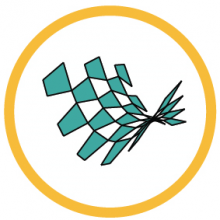Higher Order Paneling of Architectural Freeform Surfaces

Freeform architecture has become increasingly popular in recent years, which contributed to the emergence of the research field Architectural Geometry. One major aspect is the realization of freeform facades by segmenting the designed surface into smaller, simpler parts referred to as panels. Paneling freeform surfaces typically takes into account the aesthetics of the designed surface, geometric properties, material behavior, ambient and artificial illumination, fabrication possibilities, statics, cost aspects, etc. Not only are design spaces of paneled surfaces or structures important in applications within an architectural context, but they are also of high interest in geometry processing and modern mathematical research.
Our goal is to study the design space of discrete surfaces within several paneling scenarios. We will start by investigating discrete structures that facilitate interesting panel shapes that consist of rigid surface patches, such as meshes with spherical caps as faces. We will also study properties of placing repetitive elements intrinsically along the surface, meaning that we will algorithmically generate surfaces that can be made from flexible or bendable surface elements of the same shape. Since many modern paneling methods for double-curved segments involve the use of molds, we further propose to generate surface classes where we can expect a significant reduction of necessary molds. There is a very close relation of that property to so-called Weingarten surfaces that has not been utilized before. A main goal for all these aspects is to provide the designer with a design space that breaks the existing design loop, which relies on post optimization.


